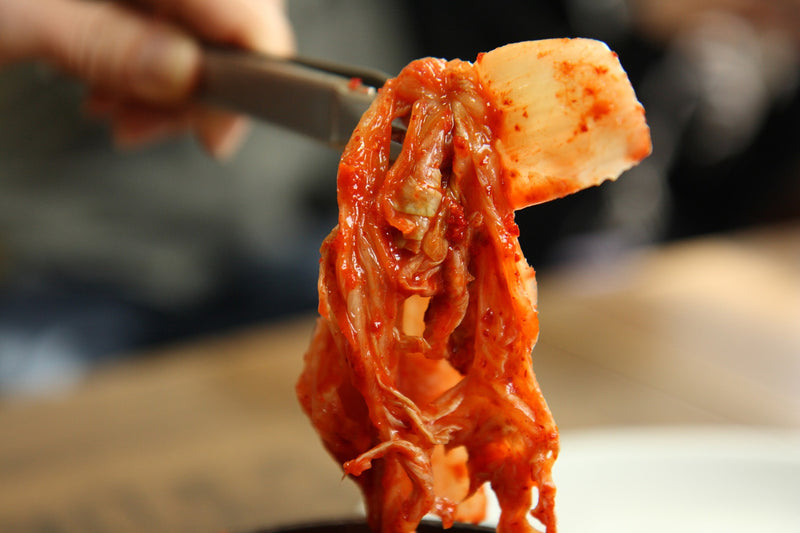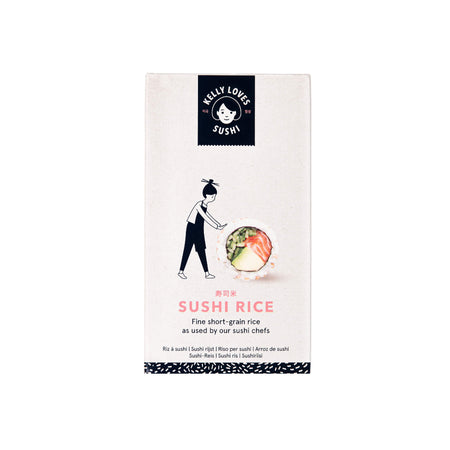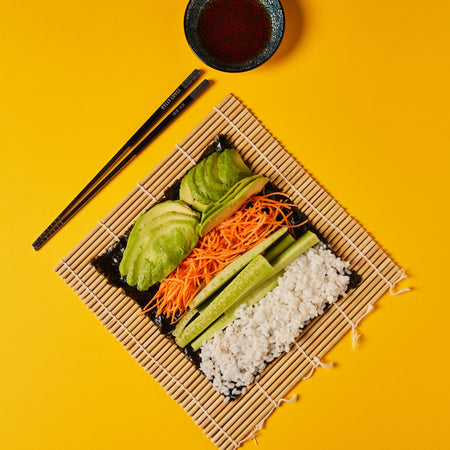A quick and easy kimchi recipe to make

Making kimchi at home means you can make large batches, knowing that none would be wasted with all those delicious ways to use up leftover kimchi (and you can even try freezing kimchi, if you like).
But if you’ve Googled ‘kimchi recipes’ and lost your nerve at the mention of creating rice porridge/paste with special glutinous flour, you aren’t alone. Luckily, you can make kimchi at home without the hassle of sourcing glutinous flour. Check out our quick and easy kimchi recipe below!
How to make homemade kimchi
To make homemade kimchi, you’ll need to consider each stage of the process. It doesn’t look so intimidating when you split the steps up into four:
- Brine the cabbage (salt it) — soaking the cabbage in salt water helps preservation by drawing out the water in the cabbage. The seasoning can also permeate more effectively (less water means a stronger flavour). It also kills any harmful bacteria, which allows the good bacteria lactobacillus to thrive when the lacto-fermentation process takes place. This process gives kimchi that moreish fizzy taste!
- Make the kimchi sauce — start by making a rice paste/porridge as a base for the kimchi sauce (optional). Then whizz together some ingredients to make a vibrant red paste (gochugaru, garlic, fish sauce, salt, sugar, ginger, onion, salted shrimp). Add the red paste to the creamy rice paste/porridge and mix together to create your kimchi sauce.
- Rub the kimchi sauce over the cabbage — really get in there: we want rich flavour in all the nooks and crannies!
- Add the kimchi to a mason jar and get ready to wait — leave the jar at room temperature on the kitchen counter for 24 hours, then pop it in the fridge for a week or so. The kimchi will continue to ferment in the fridge, just at a slower pace. Taste it as you go to see how the flavour changes.
Quick and easy kimchi recipe
Ingredients
There are hundreds of varieties of kimchi with varying ingredients, but for our quick and easy kimchi recipe, you’ll need:
- Napa cabbage — kimchi is traditionally made with napa cabbage, but there’s nothing to stop you using another type of cabbage.
- Coarse salt — preferably Korean sea salt. Many Korean dishes involve brining and salting, so having some in stock will come in handy if you love making all things Korean. Coarse salt, like sea salt, is slower to melt when compared to refined salt. This allows the saltiness to be soaked up gradually.
- Gochugaru
- Fish sauce
- Sugar
- Minced garlic
- Spring onions
- Carrots
Method
- Start by cutting your napa cabbage in half lengthwise and then cut the halves into quarters. Wash each piece really thoroughly.
- Put the cabbage in a large bowl and cover with water. Add 100g of Korean salt and rub the salt into every piece of cabbage. Leave for 2 hours.
- When the brining time is up, rinse the cabbage thoroughly under a cold tap. You don’t want the cabbage to taste too salty, so do this thoroughly and use your fingers to open and rinse between all the gaps. Leave the cabbage to drain.
- To make the kimchi paste, add to the bowl 100g of gochugaru, 3 stalks of spring onions chopped up finely, 3 cloves minced garlic, 80ml fish sauce and 1 tablespoon sugar. Mix it all together until it makes a paste (add more fish sauce if you need it).
- Next comes the bit that you’ll see at global kimchi festivals or traditional Korean gimjang (when Korean villages prepare the winter stockpile of kimchi together). You’ll need to put on a pair of plastic gloves to spread the red paste all over the cabbage. Make sure every little bit of cabbage is covered by really smooshing it in there.
- Then you can transfer your vibrant red-coated cabbage to mason jars.
You can either eat your kimchi straight away or you can leave the jars to sit on the kitchen counter for 24 hours before you move them to the fridge for that punchy, funky flavour.
There are lots of benefits to making your own kimchi, including having some fun in the kitchen and playing around with different levels of umami and spice. Not to mention that in making wholesome, homemade kimchi you’ll feel like a hero! But the traditional way to make kimchi can be intimidating and time-consuming. If you feel this way, start off by trying our quick and easy homemade kimchi method above.
Not only do many people want to eat kimchi because it’s so tasty, but the health benefits of kimchi are endless. For maximum probiotic health benefit you need to eat kimchi every day, but making your own kimchi takes effort. So many people in Korea, especially the younger generation in urban areas, buy shop-bought kimchi. Just one word of warning: not all shop-bought kimchi is equal! You need it to be authentic. For the highest quality ingredients and authentic taste, stock up on some Kelly Loves kimchi sachets. They come in handy portion sizes so you can easily access one sachet a day for optimum health benefits and taste! For more help making your own kimchi, try our kimchi making kit.









